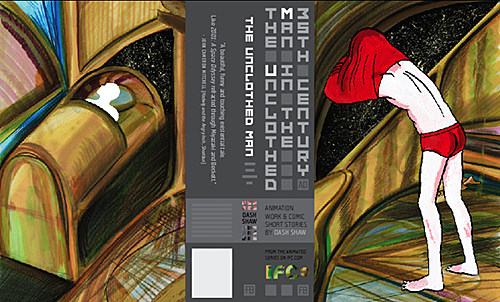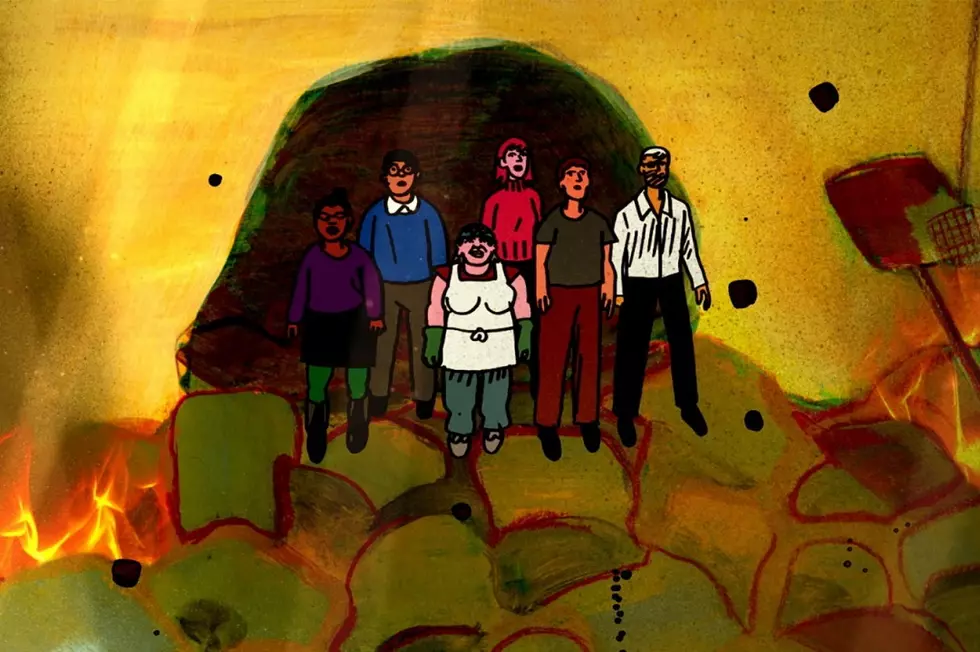
Dash Shaw Speaks on ‘The Unclothed Man in the 35th Century’

Since Dash Shaw released his 2008 graphic novel "Bottomless Belly Button" -- a 720-page book about a family coming to terms with the divorce of their elderly parents that "New York" magazine called the greatest graphic novel of the year -- and sold his webcomic "BodyWorld" to Pantheon Books for print publication, there's been a good deal of anticipation in the indie world about the next project of Dash Shaw.
Good news: The time is nigh. "The Unclothed Man in the 35th Century," comes out from Fantagraphics tomorrow in comic shops (bookstores on Jan. 6th), and collects several of his short stories from the "Mome" anthology. As a bonus for fans, he also recently released an animation series at IFC.com related to the titular "Unclothed Man" short story
, about a man named Rebel X-6 who poses as a droid model for figure classes at a futuristic art school where drawing live humans is forbidden.
Shaw talked with ComicsAlliance about his newest work as well as his own time working as an art school model, why most of his stories are romantic comedies, and how telepathy would make for a pretty interesting drug experience.

ComicsAlliance: Where did the idea for "The Unclothed Man In the 35th Century" come from? Was it a natural progression during your work on "BodyWorld," or something completely independent that you found could fit together?
Dash Shaw: I drew "The Unclothed Man" story before "BodyWorld," actually. But I did the animations after "BodyWorld." The story for "Unclothed Man" started in 2006. I'd graduated SVA [The School of Visual Arts] and my main focus at SVA was figure-drawing, mostly James McMullan's High Focus drawing class. After I graduated and moved to Richmond, Virginia, I wanted to stay connected to figure-drawing so I got a job as a figure-drawing model there. I did that because I thought it would improve my drawing, and wasn't expecting it to make me as self-conscious as it did. It's really hard, not just physically to hold something for hours and feel unusual parts of your body go through different stages of numbness, but psychologically. It's like a self-conscious paranoia. So that combined with all of these different, almost warring, ideas of how drawing classes should be taught.
The McMullan class at SVA was a polar opposite to the kinds of classes in Richmond, where there was one pose for months and months and it was more about slowly charting and mapping a figure. There are different schools of drawing all over the world. And then that combined with technology being introduced to drawing classes. People were starting to bring Wacom tablets into classrooms. And then it also combined with the obvious sexual undercurrent to figure-drawing classes, that kind of weird clinical atmosphere; it's like if you flip through an old "how to draw the figure" book it's always pin-up girls in reclining poses -- it's comical how absurd the whole thing is. So the story was a combination of all of these different things.
CA: In the book you include your storyboards from the animation series and also write about your appreciation for Japanese storyboards; was this something you started to enjoy after living in Japan during high school? Is there a storyboard book you happen to like more that the anime?
DS: I was into Japanese comics and cartoons before I went there. When Disney released "Nausicaa" they made it a double DVD, with the second DVD being just the drawings that Miyazaki drew. Now, I like the actual "Nausicaa" movie a lot. I really love it, but I love that second disc to death. It's a very emotional experience to watch the whole movie in that preliminary form. I recommend that everyone watch it. In non-anime movies, there's a book called "From Star Wars to Indiana Jones: The Best of the Lucasfilm Archives" that has a lot of beautiful Indiana Jones storyboards in it. And the recent book on Ralph Bakshi has a page of Peter Chung drawn storyboards for "Fire and Ice" which are definitely a lot better than the "Fire and Ice" movie.

CA: What manga do you see as having the biggest impact in comics today? And which were the biggest influences for you?
DS: That's hard to say. I'm not a comics historian. I think more about the psychology of cartoonists, and I can only do that so many years back before I have trouble picturing what people are thinking about. It also depends on what section of comics you're talking about. If you're talking about which mangaka has the biggest impact on comics in the entire world, I would say Osamu Tezuka, because that dominates Japan and then Japanese comics are all over the world now. But if you're asking which manga has the biggest impact on American comics as a whole, I would probably say "Lone Wolf and Cub," through Frank Miller, because of Miller's huge impact on American comics.
You could keep getting narrower and narrower, because there are so many different comics being made today, there's such a wide range of material. And all of these cartoonists are different people and what comics these cartoonists like is a reflection of their personality. It's exciting. Also, usually people get their history in reverse, so "Scott Pilgrim," or some of the other books in that current wave, I'd say started mostly being influenced by Paul Pope but then they're going backward in time from him and finding other things. I thought the fourth volume of "Scott Pilgrim" felt very Tezuka-esque to me, more so than the other volumes. And that's if we're just talking about that small section of contemporary comics. In that same pool I'd say "Blade of the Immortal" and "Ranma ½" are influential.
When I pick up a Marvel or DC book that looks sort of manga-influenced, it's usually from the Joe Madureira school, where the storytelling isn't like manga but the characters are influenced by "Fatal Fury," Capcom character designs, and manga like "Berserk" and "Bastard." But then in I guess more "alternative" or "artsy" new comics there's more of a Seiichi Hayashi influence, in books like "Asterios Polyp" or the second volume of "Powr Masters." The important thing is that all of these different kinds of comics are being made right now and they're all coming from different people. As for me, I like a lot of different things. I'm not a discriminating reader of comics, which is a problem, I think. I can read just about any comic, but I definitely wouldn't read any all-word book. I would say that "Bottomless" looks like the Tsuge comics that he did for the library circuit. Those haven't been translated yet, because they're not as good as his other, "real" comics! Ha! That's sad that the first thing that came to mind was a good cartoonist's worst work! This interview is depressing me now so I'm going to go to the next question.

CA: Much of your released work has been sci-fi related; what are your primary sci-fi influences? Are you still working in that area when creating now?
DS: I'm doing an animation now that has very slight sci-fi content. I don't know if that qualifies as sci-fi, things like Kobo Abe's "Face of Another" or DeLillo's "White Noise." So I guess when the animation is done other people will decide what genre it is. And the comic I'm working on now is about children in danger, which is maybe a genre onto itself, but that's not sci-fi. A few short stories I did, "Unclothed Man," and "BodyWorld" are more science fiction-y. I like a lot of sci-fi comics, movies, and books. Jane, who worked on "Unclothed Man," only reads sci-fi. She basically doesn't have any interest in any other kinds of books or movies. It has to be sci-fi for her. I could ramble a bunch of sci-fi things I like, but I'll just pick five off the top of my head: (these aren't in any order) 1. Philip Jose Farmer's "RiverWorld" and "DayWorld" series, 2. Dick Calkins-drawn "Buck Rogers in the 25th Century," 3. Paul Pope's "THB", 4. Peter Chung's "Aeon Flux" cartoons, 5. the Meathaus cartoonist's sci-fi books.
CA: There are so many examples of technology and culture progressing together in your work, yet those advancements are limited by humanity in certain ways. Can you talk about you thoughts on how you view a future society? (Fairly or not, I find similarities between your work and "Transmetropolitan.")
DS: I don't think of "BodyWorld" or "Unclothed Man" as being about future societies. They're about the present day, it's just that I think the present day is very much like a future society. Even in "Bottomless Belly Button," the time isn't clear; it's a combination of different time periods. With "BodyWorld," it's very clear when I drew it. There are references to MoveOn.org, civil war and ideas about the effects of the internet and globalization. You can tell that it was about 2007 to 2009, when I drew it. The only real connection to a future society that "BodyWorld" has is that the town, Boney Borough, is modeled after Disney's original vision for Epcot Center, which was originally going to be a city where people lived instead of just an amusement park. But that comes from wanting to be an "imagineer" (the people who design the Disney theme parks) when I was little. I would collect maps for theme parks and draw my own theme park designs.

CA: Speaking of comparisons, your work has elements of meta-humor one can find in other webcomics like "The Perry Bible Fellowship." Why do you think this type of humor has connected so strongly with an online audience?
DS: I don't know about "meta-humor"... that means that it's jokes about jokes? Like, playing with certain conventions of humor? I've never thought about that. That sounds more like Mark Newgarden territory. "Perry Bible Fellowship" has some of that, I guess, when he's playing with the gag being drawn like a specific person, but most of his comics are usually little perfect weirdo haiku-like gags. And I think of my humor as being more character-driven. I can't do 3 panel gags. In "BodyWorld," the humor's usually about two different characters interacting with each other. But in general I'd say that the internet has allowed people with odd senses of humor to find things that they like, that wouldn't normally be in "mainstream" newspapers or publications.
CA: The new website design is great. How important was the design for the print version of "BodyWorld"?
DS: The new website design was done after I did "BodyWorld," so the two are unrelated. The new website design was done by Mari Povich. She just e-mailed me and offered to redesign the site. But the design of the "BodyWorld" print edition is modeled after keeping the vertical, long scroll-like reading of the online version. It has a top and bottom page instead of a left and right page, and the maps that opened on different "tabs" on the computer fold out as flaps from the covers of the print edition, so you can see the comic and the maps simultaneously. The spine is rounded so it lies on its back easily.
CA: Are you at all worried that new readers will feel daunted by the complexity of the story and even the physical book in its layout?
DS: Not really. The story doesn't seem that complex to me, but I drew it. The vertical design of the "BodyWorld" book is unusual, but it's the best way to read that comic, so that's that. If it doesn't sell, it doesn't sell. I'm drawing other things now.

CA: In Episode 2 of "The Unclothed Man," it's pointed out twice that something was a dream. In "BodyWorld" there are arrows to point out moments from panel to panel at times. Are these, and other elements, things you feel are necessary to help readers, or something that's wholly born out of your aesthetic?
DS: Well, the "Unclothed Man" sequence you're talking about would be fine without that "dream" text. It would make sense. I liked the way it looked and the pace of it with the text. So I guess it comes from my aesthetic. But I'm not opposed to writing something on the page to dumbly mark or notate something. Everything in comics is weird communication notes; panels for time or space, word balloons for speech. These are all devices, and I don't mean "device" in a negative way. It's like if you're writing down a "to do" list, you'd put each task on its own line. It's an intuitive, graphic decision that notes something to your self.
CA: Where did the inspiration from the "All Your Base Are Belong To Us" sequences in the animation come from?
DS: Obviously, that's from 8 bit videogames. Since it's mostly no voice acting in those animations, I wanted to vary how the text was presented depending on the text. So the 8-bit text is used for some of the narration, and other text is in word/thought balloons, messages, or silent film title cards.
CA: Can you talk about the ideas in the short story "Satellite CMYK"? They seem to have elements from stories like "THX" and "Brave New World" -- this idea that the future is dominated by class structure.
DS: To me, that story's about returning to the same things over and over again, throughout your whole life. It's like people are shedding skins as they grow older, but they're doing the same things. So it's the story of one person's life as he's moving down the layers, separated by facial-recognition software, so he looks slightly different at each level. His memory is wiped at each level, so he doesn't remember the previous versions of himself. It's all told simultaneously, in color-coded horizontal tiers, to recreate that experience. At the first level, he's in love with a girl. In the second level, he's with the same girl (unknown to both of them) but she breaks up with him. In the final level, he's with someone who betrays him but he's finally lowered down to the earth where he'll meet back up with the first girl again. It's a love story! If you flip through the "Unclothed Man" book, you'll see that all of the stories are basically romantic comedies. It's the only genre I'm consistently in. 
CA: What are the benefits of working in animation as opposed to comics? And vice versa?
DS: They're very different but I like both because they're both drawing. Drawing is what connects them for me, and narrative. I'm not interested in non-drawn animation, and I would never do a live-action movie. Animation is a beautiful process. You're sitting at home thinking about how someone would move through space or do a simple task, like slide something off of a table, and breaking it down moment-by-moment. Doing animation increases your sensitivity to your body, because you have to think about how you walk and move. You have to do a million little drawings for the most mundane things. You could do a comic like that, but it'd take a lot of pages and very little would happen, which is I guess what "Bottomless" is like. Now that I'm doing animation more, my comics are getting leaner, tighter, and more detailed. If you do a hundred drawings of someone sitting down for an animation, you want to work on one detailed comic page next, to keep yourself balanced.
CA: A lot of your work ties into art schools, and even rebellion against them. What was your experience like at the School of Visual Art?
DS: I went to art school, so I think about it. I think most artists, now, went to art school. I think the art school stories come from digesting that experience and trying to address it directly; because art school definitely isn't a romantic thing for an artist to address or face up to. It's just not a romantic origin story for an artist to have. It has different effects on people, and I've been through a lot of them. Artists will graduate and want to look untrained, unschooled, like folk art, because folk artists are definitely more romantic and mysterious than another BFA graduate. I've been guilty of that mentality, especially coming from SVA, which was very illustration-oriented for me. Another direction is just feeling like you're a combination of all of the classes that you took: drawing like McMullan, painting like [Steven] Assael, etc.. And I'm guilty of having that feeling too. And, of course, there are people who just stop drawing after art school because it fed them too much bullshit. I'm glad I went to SVA, even though I spent the majority of my time there wondering whether or not I should drop out.

CA: What do you want people to get out of your work?
DS: I haven't thought about that yet. Don't make me!
CA: What are the best drugs?
DS: I understand where you're coming from with this question, but the drug in "BodyWorld" is telepathy, so that book is about telepathy, not drugs. I don't feel connected to drug culture the way that underground comics were. But maybe that's because my parents are hippies and my Dad read those comics, so I'm the generation after that material. The telepathy sequences in "BodyWorld" are, honestly, me thinking about how telepathy would work and my attempt at drawing that experience as accurately as I could from the perspective of the characters experiencing it. It isn't just a collage of "trippy" stuff, or a recreation of an experience of a drug that exists.
The way telepathy has been done in most fiction is that it's just a secret whisper, unspoken words moving from one person to another. That's bulls--t to me, and just another example of the brain's sense of importance over other parts of the body. I don't think telepathy would be limited to the brain. If one part of the body is communicating to another part of the body, it would happen to the other parts of the body. And I don't feel that people think exclusively in words. So the "levels" of the telepathy in "BodyWorld" are just my ideas about how this would happen.
That said, if there was a telepathy-inducing drug, I think it should be experimented with, in a controlled environment, and I would definitely want to try it. But it's dangerous because if it becomes too widespread, it would lead to a hive mind, which is what happens in "BodyWorld." However, eventually, after the hive mind has become the norm, then people would find ways to "shield" their bodymind from the other members of the hive and things would return to almost exactly the way things are now, pre-telepathy. But that would all happen many years after the "BodyWorld" story ends.
More From ComicsAlliance


![Dash Shaw’s ‘New School’ Delivers Bewildering Color & Complex Emotions [Review]](http://townsquare.media/site/622/files/2013/07/It-is-good.jpg?w=980&q=75)






